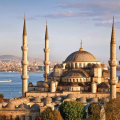BLUE MOSQUE (SULTANAHMET CAMII)
Every year, millions of travellers from all over the world come to visit this pure architectural wonder.
The complex occupies the site of the ancient Byzantine Grand Palace - which remained an imperial residence until the sacking of the city by the Latins in 1204 - and part of the Roman hippodrome. Initially, the complex included a mosque, elementary schools, a medersa, a covered market, a hospice, a dervish convent, a popular canteen and mausoleums. Some of these buildings have disappeared over time. With its six minarets, dome and half-domes that made its silhouette famous, the Blue Mosque was built between 1609 and 1617 by the architect Sedefkar Mehmed Ağa, a disciple of the genius Mimar Sinan, for and in the name of Sultan Ahmed III (hence its name). It is accepted as the last great imperial construction of an already declining empire. Located in the centre of the complex, the Blue Mosque rivals Saint Sophia from which it is separated only by a vast esplanade. It has a large central space surmounted by a dome 33.60 m in diameter and whose summit is 43 m high. All the walls are covered with Iznik ceramics in blue and green tones, depicting carnations, tulips and stylised roses. Blue was the origin of the mosque's western name, despite the presence of other colours. The combination of these ceramics and the light created by 260 windows gives the whole its magnificence. There is also a piece of the Black Stone revered in Mecca, framed by two large candelabra.
Did you know? This review was written by our professional authors.
Members' reviews on BLUE MOSQUE (SULTANAHMET CAMII)
The ratings and reviews below reflect the subjective opinions of members and not the opinion of The Little Witty.










A voir absolument